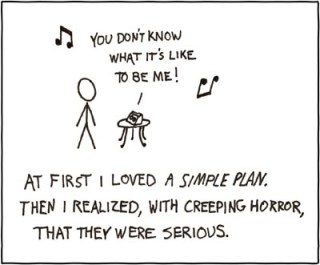Change part 4: broken pieces
“I was never one to patiently pick up broken fragments and glue them together again and tell myself that the mended whole was as good as new.  What is broken is broken — and I’d rather remember it as it was at its best than mend it and see the broken places as long as I lived.” – Margaret Mitchell
What is broken is broken — and I’d rather remember it as it was at its best than mend it and see the broken places as long as I lived.” – Margaret Mitchell
This post is kind of a hybrid of management of change (part 2) and embracing change in plans (part 3) and whatever else you can think of with regard to change (parts to continue ad nausea).
So. I begin with … it drives me crazy when a manager’s plan falls apart and then they run around (or have their “people”) trying to put all of the broken plan pieces back together again solely so they can “stay with the plan.”
Ok. That was a generalization.
Some pieces of a plan are more important than others. You save those. And most times those pieces don’t break off that easily anyway.
Regardless.
When a plan is broken super gluing it back together again is probably not the best plan of action.
Yet. Time and time again you see leaders slavishly having people run around sticking pieces back onto the plan like little barnacles on a ship.
Hmmmmmmmmmmmmmmmmmmmmmmmmmmmm. Why? (me asks myself).
Well. Interestingly a leader runs into a different aspect of the same issue the organization is dealing with.
While the organization (and people in general) typically hates change it helps they have a plan to follow (kind of like going on a trip and at least you have a map), the leader likes a plan to implement change and yet hates changing the plan (despite the fact it is all directed to creating a change).
Yikes. That was confusing. Maybe even contradictory <assuming I could actually unravel what I just wrote>.
Suffice it to say … human nature says we want the plan to stay the same but are not opposed to it being better (ahhhhh … the contradictions in life).
“Our dilemma is that we hate change and love it at the same time; what we really want is for things to remain the same but get better.”
Sydney J. Harris
So. In practicality the organization (people) loves having the plan but inevitably will be shaking their head over some things and say “wouldn’t it be better if we do this?” <and begin assessing some personal control over the situation and start implementing change on their own). <please note: that is typically not good>
 This is where I go back to the beginning where I said I hate managers who maniacally glue the plan back together when it breaks. The organization, the people, in the midst of the change transition start implementing plan changes (let’s call these, at their best, course corrections) and then you have managers running around with glue putting the original plan back together again and, well, that would be called ‘disorganization’.
This is where I go back to the beginning where I said I hate managers who maniacally glue the plan back together when it breaks. The organization, the people, in the midst of the change transition start implementing plan changes (let’s call these, at their best, course corrections) and then you have managers running around with glue putting the original plan back together again and, well, that would be called ‘disorganization’.
Or maybe negative energy.
Or maybe even wasted energy.
At its worst it is unadulterated chaos.
(needless to say … on the McTague good bad scale that is bad for an organization)
I would suggest to leaders “go with the flow” when a plan breaks apart <but I tend to believe that is slightly too flippant and as most leaders have an aspect of ‘control freak’ that never goes over well>.
In the end change is a funny thing. In business it is often the same as in life.
There may be a grand plan and a vision. But during the ‘change’ we <personally and/or organizationally> are never quite sure what we are becoming, or why. In organizations … and within leaders … most are pretty uncomfortable with that truth.
But then one day we look at ourselves, and wonder who we are, and how we got there. But if it’s done right we are pretty happy with what we see.
And if we are really true to ourselves … be honest … we will have changed in some way by being broken … and then picking up some old pieces, and some new pieces, and just “are” … ‘are’ being a new version of you (no superglue involved).
So.
All that said (because this is about gluing together broken plans) great leaders recognize that the people they started with in their organization will not be the same people when the “change” is done.
What this means is that a leader can’t glue back the original employees into the plan … they have changed.
And treating them as the unbroken original is silly (and non productive if not chafing). Change means breaking from what is. And assume a change plan of action will change. If you don’t, have lots of superglue.
Oh, by the way, employees (and people in general) don’t like to follow a plan that has been superglued back together again.


Leave a Comment